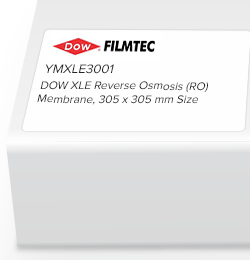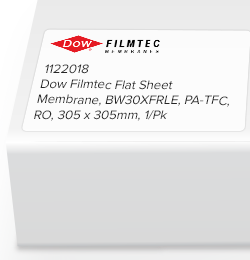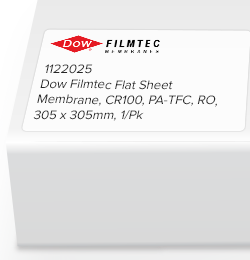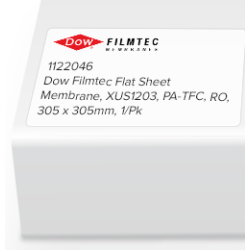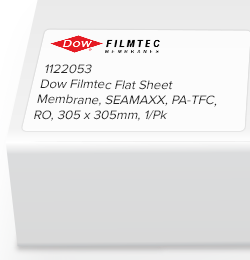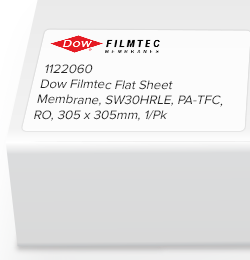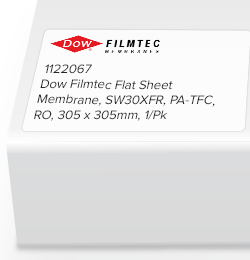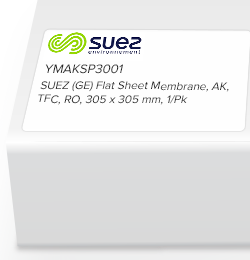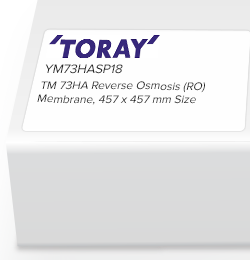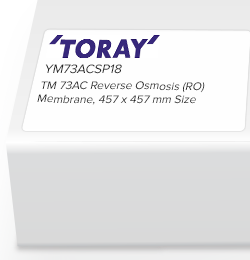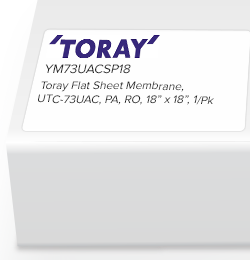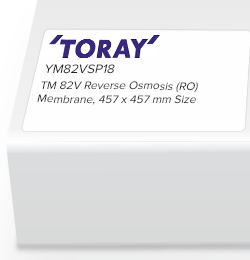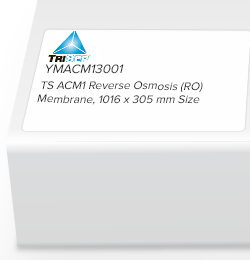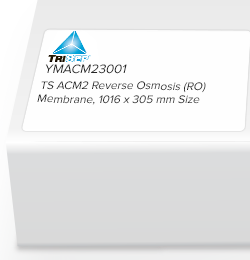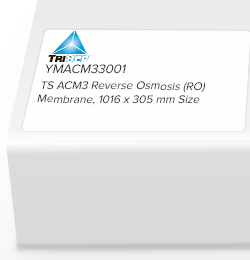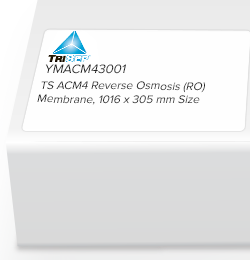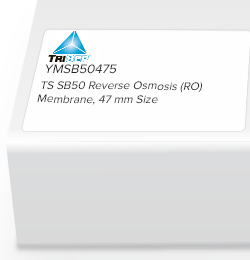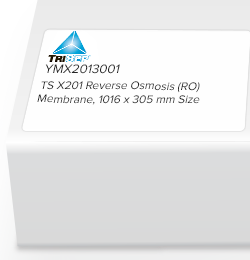Dow Filmtec Flat Sheet Membrane, BW30, PA-TFC, RO, 305 x 305mm, 1/Pk
Details
Dow Filmtec Flat Sheet Membrane, BW30, PA-TFC, RO, 305 x 305mm, 1/Pk
Specifications
RO Flat-Sheet Performance Comparison by Manufacturer:
Go To: FilmTec | Suez | Toray | TriSep
FilmTec™
| Series |
XUS1808 discontinued |
XC70 discontinued |
XC80 discontinued |
|||||||
|---|---|---|---|---|---|---|---|---|---|---|
| Feed | Industrial/Wastewater | Brackish Water | Industrial/Wastewater | Chemical/Petrochemical/Steel | Chemical/Petrochemical/Steel | Chemical/Petrochemical/Steel | Sugar/Pharmaceutical | Seawater/Brackish Water | Seawater | Seawater |
| Type | Ultra-High Pressure | Extra-Low Energy | Low Energy | Low Energy | High Recovery | High Recovery | Low Energy/High Recovery | High Rejection/Low Recovery | Low Energy/High Recovery | |
| pH Range (25°C) | 2-11 | 2-11 | 1-13 | 1-13 | 1-13 | 1-13 | 1-13 | 1-13 | 1-13 | 1-13 |
| Flux (gfd)/psi | 22.4/225 | 33-41/125 | 28.8/150 | 28.8/225 | 22.0/800 | 20.6/600 | * | 38.6/600 | 18.1/800 | 18.5/800 |
| Rejection | 99.7% | 98.7% | 99.3% | 99.7% NaCI | 99.75% NaCI | 99.47% NaCI | * | 99.47% NaCI | 99.75% NaCI | 99.82% NaCI |
| Pore size/ MWCO | N/A | N/A | N/A | N/A | N/A | N/A | N/A | N/A | N/A | N/A |
| Polymer | Polyamide-TFC | Polyamide-TFC | Polyamide-TFC | Polyamide-TFC | Polyamide-TFC | Polyamide-TFC | Polyamide-TFC | Polyamide-TFC | Polyamide-TFC | Polyamide-TFC |
Veolia
| Series | |||
|---|---|---|---|
| Feed | Brackish Water | Brackish Water | Industrial/Wastewater |
| Type | Reactive Silica Removal | Low Energy | Chlorine Resistant, High Pressure |
| pH Range (25°C) | 1-11 | 1-11 | 1-11 |
| Flux (gfd)/psi | 26/225 | 26/115 | 22/425 |
| Rejection | 95.5% | 99.0% | 98.9% |
| Pore size/ MWCO | N/A | N/A | N/A |
| Polymer | Polyamide-TFC | Polyamide-TFC | Polyamide-TFC |
Toray™
| Series | ||||
|---|---|---|---|---|
| Feed | Brackish Water | Brackish Water | Brackish Water | Seawater |
| Type | Extra-Low Energy | High Rejection, Low Energy, Cl Resistant | High Rejection, Low Energy | High Rejection, Low Energy |
| pH Range (25°C) | 2-11 | 2-11 | 2-11 | 2-11 |
| Flux (gfd)/psi | 23.3/73 | 30.7/225 | 29-40/150 | 27/798 |
| Rejection | 99.0% | 99.8% | 99.5-99.7% | 99.7% |
| Pore size/ MWCO | N/A | N/A | N/A | N/A |
| Polymer | Polyamide-TFC | Polyamide-TFC | Polyamide-TFC | Polyamide-TFC |
TriSep™
| Series | ||||||
|---|---|---|---|---|---|---|
| Feed | Brackish Water | Brackish Water | Brackish Water | Brackish Water | Industrial/Wastewater | Industrial/Wastewater |
| Type | "Tight" | Standard | Low Pressure | Low Pressure, High Flux | Cl Resistant | Fouling Resistant |
| pH Range (25°C) | 2-11 | 2-11 | 2-11 | 2-11 | 4-7 | 2-11 |
| Flux (gfd)/psi | 25/225 | 30/225 | 35/225 | 30/150 | 30/420 | 30/225 |
| Rejection Values | 99.5% | 99.5% | 99.3% | 99.2% | 95.0% (99.0% MgSO4) | 99.5% |
| Pore size/ MWCO | N/A | N/A | N/A | N/A | N/A | N/A |
| Polymer | Polyamide-TFC | Polyamide-TFC | Polyamide-TFC | Polyamide-TFC | Cellulose Acetate | Polyamide-urea-TFC |
 Frequently Asked Questions
Frequently Asked Questions
Q: How do I clean the flat sheet membranes?
In general, caustic solutions (for example 0.01 to 0.05% aqueous sodium hydroxide solutions) are used for organic foulants and acidic solutions (for example 0.1 to 0.2% aqueous HCL solutions) are used for inorganic foulants. It is important to perform the caustic cleaning first to remove organic foulants since some organics can be irreversibly linked to the membrane at low pH. Please refer to the membrane cleaning article at https://www.sterlitech.com/blog/post/membrane-chemical-cleaning for more information.
Q: I have a polymeric stirred cell and discovered that my disk size is not listed in the ordering information for the flat sheet membranes. Can I purchase the flat sheet membranes in the correct disk size for my stirred cell?
Yes, we can supply the flat sheet membranes in the correct disk size for your stirred cell. Please contact us at [email protected] for pricing and availability.
Q: How do I store used flat sheet crossflow membranes?
Q. How do I store used flat sheet crossflow membranes?
A. Used flat sheet membranes must always remain wet, including during storage. Membranes that are allowed to dry will irreversibly lose water permeability. To prevent microbial growth, the membranes can be stored in a 0.5% solution of formaldehyde. Alternatively, the membranes can be stored in a 1.0% solution of sodium metabisulfite (SMBS). To maintain efficacy, the SMBS solution should be replaced monthly. Or the membranes can be stored in UPDI water that is replaced weekly.
Q: Are the flat sheet membranes available as roll stock?
Yes, we are able to offer some of the flat sheet membranes as roll stock. Please contact us at [email protected] to inquire about pricing and availability.
Q: Why is the flat sheet membrane I'm using measuring a flux value less than the published flux value?
Flow characteristics for a spiral element and flat sheet membrane are significantly different and are really only comparable on a qualitative basis. Variability in the membrane manufacturing process, differences in water composition, test procedures, and test equipment, used in a factory, laboratory, or elsewhere, will impact water flux results.
Q: Do you offer samples of the flat sheet cross flow membranes?
We do not offer complimentary samples of the flat sheet crossflow membranes. However, most customers find the standard pack quantities to be quite reasonable for initial evaluations. For customers that want to evaluate several different membranes, we do offer custom variety packs. And, in some instances, we may be able to offer custom packs containing smaller sheet quantities. Please contact us to inquire about pricing and availability.
Q: What is the shelf life for the flat sheet crossflow membranes?
Prior to use, the membranes should be stored in a climate controlled environment, away from sunlight and heat, while sealed in the original packaging. We recommend using the membranes as soon as practical after receiving them. However, most of the flat sheet membranes may be stored for up to one year without affecting performance. The exceptions are the GE cellulose acetate membranes (CE and CK) and the Aquaporin FO membrane which should be used within 6 months.
Q: How do I store used forward osmosis (FO) flat sheet membranes?
Q. How do i store used forward osmosis (FO) flat sheet membranes?
Post use, the membrane should be rinsed with water after testing and stored in clean water if the storage duration will be less than 24 hours. If the membrane is rinsed with water and expected to be stored for longer than 48 hours, it is recommend to use a 1% sodium metabisulfite (SMB, chemical formula Na2S2O5) to prevent bacterial growth from occurring. Periodically inspect the membranes for biological growth. If the preservative solution is cloudy you need to replace it. Renew the preservative solution every month.
Q: Can I reuse flat sheet membranes after they have been removed from a test cell?
Yes, you may attempt to reuse flat sheet membranes. However, you may find it difficult to achieve a leak free seal. The cell body o-rings necessarily compress the membrane during installation and the physical action of separating the membrane from the o-rings during removal may cause damage. This damage can impede that ability to achieve a leak free seal when the membrane is reused.
Q: I accidentally allowed my flat sheet crossflow membrane to dry out. Can I still use it?
Unfortunately, allowing a previously wetted crossflow membrane to dry usually results in permanent reduction of water permeability. Nevertheless, you can attempt to re-wet the membrane and use it. First, soak the membrane in a 50% alcohol solution for at least 15min (ethanol, methanol, or IPA would be acceptable). Next, install the membrane in the test cell and operate the cell with purified deionized water as though you were pre-conditioning the membrane. After about 30min, the permeate flux should stabilize to whatever rate the membrane is now capable of.
Q: How do I store used flat sheet crossflow membranes?
Used flat sheet membranes must always remain wet, including during storage. Membranes that are allowed to dry will irreversibly loose water permeability. To prevent microbial growth, the membranes can be stored in a 0.5% solution of formaldehyde. Alternatively, the membranes can be stored in a 1.0% solution of sodium metabisulfite (SMBS). To maintain efficacy, the SMBS solution should be replaced monthly. Or the membranes can be stored in UPDI water that is replaced weekly.
Q: Do I need to pre-condition the flat sheet membranes? And, if so, what is the recommended procedure?
Yes, for flat sheet membranes that will be used with water or aqueous solutions, we recommend that you pre-condition the membranes prior to conducting your separation experiments. Pre-conditioning helps ensure that the membranes perform as expected. Also, pre-conditioning removes preservatives and other residuals from the membranes. Purified deionized water is used to pre-condition the membranes. For all flat sheet membranes except the forward osmosis (FO) membranes, install the membrane in the test cell and apply the purified deionized water feed at the normal operating rate and pressure for the membrane. Allow the system to operate with the purified deionized water feed until the permeate flux stabilizes at an expected value. You can now replace the purified deionized water feed with your feed solution and begin your experiments.
Q: What is the recommended cross flow velocity (CFV) for the flat sheet membranes?
Most membrane manufacturers recommend CFVs of 5 to 35cm/s for their spiral wound membrane elements. The flat sheet membranes can be operated in this range to simulate use in such elements. Additionally, the flat sheet membranes may be operated outside of this range by users that want to examine the relationship between CVF and fouling and membrane performance in their applications.
Q: How do I calculate the cross flow velocity (CFV) for flat sheet membranes?
Cross flow velocity (CFV) is the linear velocity of the feed flow tangential to the membrane surface and is typically reported in m/sec or ft/sec. It is calculated by dividing the volumetric flow rate through the feed channel by the cross-sectional area of the feed channel. Please refer to the CFV article at https://www.sterlitech.com/blog/post/tech-tips-cross-flow-velocity-cfv/ for more information.
Q: What is the recommended transmembrane pressure (TMP) for the flat sheet membranes?
The recommended TMP will depend on the type of flat sheet membrane and on the application. Typically, a reasonable TMP will be the same as that noted for the permeate flux specification of the membrane. The specifications for any of the flat sheet membranes can be easily found on our website by clicking the “application/specification” tab on the product web page and scrolling down as necessary. Please contact us at [email protected] if you need additional assistance.



